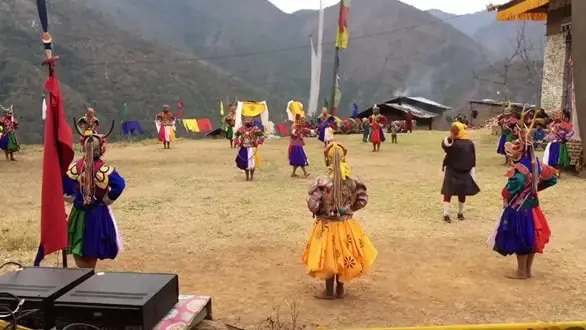The pristine beauty of Arunachal Pradesh gets all the more beautiful with the use of the cultural vibrancy. The dances offer a visual treat to the art lovers. The unique traditional solutions and rituals are parts and parcels of Arunachal Pradesh and these dance forms capture that essence in every respect. So let us dive in to this world different dance forms produced by this state.
1. Bardo Chham:

Monpa Bardo Chham, a spiritual dance in Tawang, Arunachal Pradesh, blends art, religion, and culture. Tibetan Buddhist Guru Padmasambhava is honored in this spiritual dance. Bardo Chham’s religious festival performances go beyond entertainment to become a spiritual rite that preserves Monpa culture. The ornate costumes and masks of deities, demons, and animals make Bardo Chham dancers appealing. Exquisite costumes and masks communicate the dance’s spirituality. Each dancer’s outfit depicts Guru Padmasambhava’s teachings. Fluid and rhythmic movements lead the audience to a spiritual realm in the exquisite and complicated dance. Buddhist dancers narrate tales with well-choreographed movements. The dancers gracefully whirl and move to the music, including historical narratives.
2. Ponung:
Festivals and festivities of Arunachal Pradesh’s Apatani people include Ponung, a vibrant dancing form. This lovely dance displays Apatani culture’s lively traditions, craftsmanship, agriculture, and community.Ponung dancers’ elaborate costumes are first impressions. Apatani apparel includes bamboo headgear, cane rings, and beautiful jewelry. These exquisite garments show the Apatani community’s creativity and traditionalism.The rhythmic, expressive Ponung dance represents Apatani culture. Its dance reflects their agrarian culture. The dancers’ graceful steps symbolize sowing seeds, transplanting paddy, and celebrating a good harvest. Ponung’s every gesture symbolizes the Apatani people’s deep connection to the earth.
Ponung’s folk music goes beyond dancing. The dance lyrics describe Apatani communities’ joys, sorrows, hardships, and accomplishments. Traditional and memorable, they protect community history and values. Ponung honors Apatani farming and togetherness.Ponung reflects Apatani culture beyond entertainment. Their ideals, beliefs, and traditions are there. This dance stresses agriculture and the Apatani community’s bond to nature and land. Ponung illustrates that challenges and life’s little and major joys build community.Ponung embodies Arunachal Pradesh’s cultural diversity and Apatani identity. It celebrates their art, tradition, and love of home. Ponung connects generations and preserves Apatani culture. All are welcome to join the Apatani celebration of life, culture, and community.
3. Idu Mishmi:
The Idu Mishmi community weaves culture, spirituality, and tradition into Arunachal Pradesh’s lush landscape with their colorful dance style. This beloved dance is performed at weddings and harvest festivals. The extravagant costumes and decorations, flowing dances, and deep connection to nature and spirituality make the Idu Mishmi dance more than entertainment; it expresses their beliefs, stories, traditions, and rites. Idu Mishmi dancers in traditional clothes perform. Idu Mishmi culture is shown by their lovely physique and exquisite costumes and decorations. These exquisite garments and accessories show the community’s traditionalism. Idu Mishmi dancers share centuries-old tribal tales with each graceful move. The beautiful dancers express the community’s ideals, respect for nature, and spiritual beliefs. Every action reflects Idu Mishmi tradition.
The dance shows the Idu Mishmi’s spirituality and environmental connection. They believe ghosts and deities exist in the supernatural. The Idu Mishmi dance honors Earth and spirits. Beyond its cultural significance, the Idu Mishmi dance preserves community history, customs, and rituals. A living memory transmits tales and behaviors. The dance celebrates Idu Mishmi history in a changing world. Arunachal Pradesh’s Idu Mishmi dance symbolizes culture. They honor nature, spirituality, and tradition in their art. The Idu Mishmi’s habitat, legends, and relationship to nature and spirit are shown in the dance. In Arunachal Pradesh, the Idu Mishmi dance symbolizes culture and spirituality. The dance’s beautiful clothing, graceful movements, and emotive and gesture-based plot explain their beliefs, stories, and traditions. It celebrates nature, unifies generations, and inspires with its rich culture.
4. Adi Buiya Dance:
The Adi tribe performs the Buiya Dance during harvest season in lush Arunachal Pradesh. This lovely Adi dance honors nature and agriculture. The rhythmic dance, precise hand movements, and kaleidoscope of traditional Adi attire honor their cultural and agricultural heritage in Adi Buiya Dance.Men and women happily perform the Adi Buiya Dance, securing its inclusion. Adi dancers dress traditionally. Adi people adore nature and culture, thus their dress is vibrant and detailed.A perfect recreation of planting, cultivating, and harvesting crops characterizes the Adi Buiya Dance. Their rhythmic feet mimic farming and beautiful hands show tenderness, bringing up ancient traditions. They recognize humanity’s long history with Earth.
The vibrant Adi Buiya Dance honors nature and agriculture. The Adi plant, nurture, and harvest their food from the land. The dance reminds us that agriculture represents our culture, habits, and surroundings beyond food.Buiya Dance entertains and protects Adi customs. Adi communities endure joys and pain. Harvest celebrations boost community spirit.Rich Arunachal Pradesh culture and Adi identity are represented by the Adi Buiya Dance. The joyous celebration of their cultural and agricultural history displays togetherness and commitment to the land. The energetic dance reflects their love of nature and history.The vibrant Adi Buiya Dance celebrates the tribe’s farming history. The dance praises nature and the community’s love of it with rhythmic footwork, expressive hand gestures, and Adi attire. This colorful sign represents their traditions, unity, harvest delight, and dependency on agriculture.
Conclusion
The finest dance forms of Arunachal Pradesh not only surprised the art lovers of the nations, but also those living abroad. The stunning presentation of the dances, be it Monpas or Ponung, or even Mishmi, makes the finer senses have the visual feast along with the captivating music. It is this celebration of the moments that the dances offer.
Santosh Kumar, the author behind IndiasStuffs.com, is passionate about sharing valuable insights on a variety of topics, including lifestyle, technology, and Indian culture.
Page Contents

